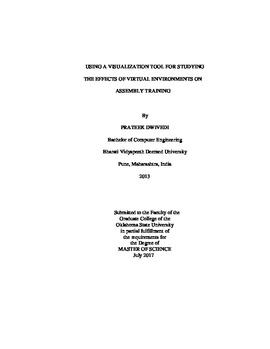| dc.contributor.advisor | Etemadpour, Ronak | |
| dc.contributor.author | Dwivedi, Prateek | |
| dc.date.accessioned | 2018-06-18T17:29:53Z | |
| dc.date.available | 2018-06-18T17:29:53Z | |
| dc.date.issued | 2017-07-01 | |
| dc.identifier.uri | https://hdl.handle.net/11244/300103 | |
| dc.description.abstract | The objective of this research is to build and demonstrate the design on Virtual Reality (VR) environment to aid in the understanding of assembly & assembly planning for complex systems. To explain the research work, a Virtual Reality environment was created for assembly simulation of Treadmill parts used in a Spacecraft. This environment will account for space related constraint such as, gravity. This study will help in understanding the assembly of the VR model which might help an assembler to optimize the design related cost. Unity 3D is used for creating the VR environment along with Solidworks to create Treadmill parts. Text and image cues are offered to assist users while performing manual assembly. The assembly sequence followed by users will be compared with an optimized path sequence computed using a Genetic Algorithm for a collision-free layout. To validate the research work, the virtual assembly simulation has been run on four distinct set ups using immersive (VIVE headset) and non-immersive (desktop) virtual reality systems. A series of user studies to achieve two primary objectives has been conducted: 1) Evaluation of simulated representations with respect to different analysis, 2) Identification of best layout in terms of correctness and elapsed time for a virtual environment. A visualization tool was employed to analyze the system and data collected from diverse set ups. An interactive visualization tool based on a Tree-Map visualization technique was developed to represent the hidden patterns in users’ behavior when they perform different tasks in a virtual environment (using head-mounted VR tool and monitor based VR) which also help in concluding that immersive virtual reality with image cue appear to be the best set up in terms of correctness and time. In addition, using this interactive visualization tool, we show the intrinsic statistical relationships between/within diverse groups of participants in the form of chord diagrams. | |
| dc.format | application/pdf | |
| dc.language | en_US | |
| dc.rights | Copyright is held by the author who has granted the Oklahoma State University Library the non-exclusive right to share this material in its institutional repository. Contact Digital Library Services at lib-dls@okstate.edu or 405-744-9161 for the permission policy on the use, reproduction or distribution of this material. | |
| dc.title | Using a Visualization Tool for Studying the Effects of Virtual Environments on Assembly Training | |
| dc.contributor.committeeMember | Cecil, Joe | |
| dc.contributor.committeeMember | Cline, David | |
| osu.filename | Dwivedi_okstate_0664M_15388.pdf | |
| osu.accesstype | Open Access | |
| dc.description.department | Computer Science | |
| dc.type.genre | Thesis | |
| dc.type.material | text | |
